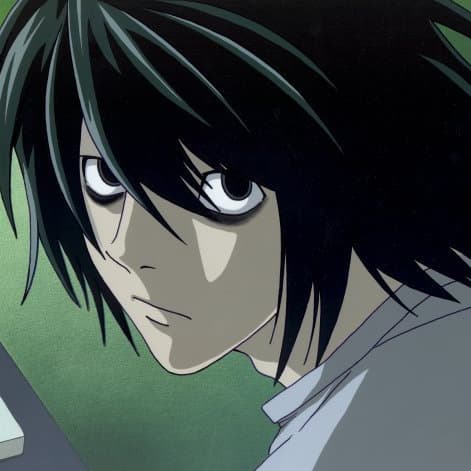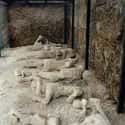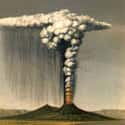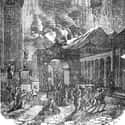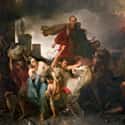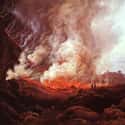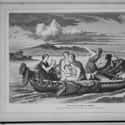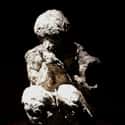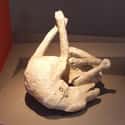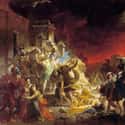-
(#1) Extreme Heat From A Toxic Wave Of Ash And Gas Killed People Instantly
Volcanic eruptions happen in phases - it isn't simply a sudden downpour of lava over the land around the volcano. Though experts have debated which stage of the eruption people were most likely to succumb to, one thing is clear: None of them would have survived the fourth pyroclastic surge, a wall of searing ash and gas that quickly slammed into the city in the early morning of August 25.
When these boiling toxins hit someone, they immediately cause muscle contractions and what one expert called "heat shock" - and this accounts for the crouched, curled positions in which historians discovered so many of the victims. The heat and gas instantly killed anyone it hit, which included everyone who remained in the city. Since they passed in less than a second, there wasn't time for them to feel anything.
-
(#2) A Giant Cloud Blotted Out The Sun - And Pompeians Spent Their Final Hours In Complete Darkness
Erupting volcanoes emit gases and volcanic chaff high into the air, and Vesuvius was no exception. On August 24, the day of the fateful eruption, a giant cloud - in the shape of what Pliny the Younger described as an "umbrella pine tree" - shot out of the volcano and into the air.
It was so thick, it blotted out the sun - some Pompeians never saw sunlight again. Though it was the middle of the day, the city became cloaked in darkness. Anyone who attempted to flee the city had a difficult time seeing where they were going.
-
(#3) The Air Likely Smelled Awful
Like many ancient cities, Pompeii stunk even before that fateful August day in 79 CE. But as the volcano was erupting, the air quality worsened due to the thick, toxic gas. Pliny the Younger, witness to the natural disaster, noted how the smell of sulfur in the air intensified before the volcano erupted.
The volcano likely spewed hydrogen sulfide, heralded by a distinct scent reminiscent of "rotten eggs." Between the sulfur and smoke, the smells compelled some Pompeians to repurpose their tunics by tying them around their faces.
-
(#4) Falling Rocks Killed Many People Who Tried To Escape
Though the earth trembled for days before the eruption, the situation turned deadly on August 24. By evening, the volcano was spewing rocks, some of which measured roughly 3 inches wide. Escaping the storm of stones was risky, but many tried.
Not all were successful: Many Pompeians who took the gamble lost their lives from blows to the head.
-
(#5) A Chorus Of Voices Cried Out In The Evening
Chaos ensued as the volcano erupted and people realized the circumstances were more dire than they originally believed. As darkness descended across the city and the barrage of stones snowed down, people attempted to flee.
One survivor's account noted how the evening became filled with voices crying out for loved ones. In their last hours, Pompeians desperately wanted to stay safe with friends and family.
-
(#6) Some People Put Pillows On Their Heads As Protection From Rocks And Burning Ash
Vesuvius pelted Pompeii with rocks and hot ash late in the day on August 24. Though many opted to stay indoors, others braved the elements in an attempt to flee the city. Aware of the danger the volcanic debris posed, some left their homes and wore pillows tied to their heads. They intended for the soft pillow to cushion any blow to the head from falling stones.
Historians still don't know whether this protective gear proved effective.
-
(#7) Breathing In Volcanic Gas Was Painful
As Vesuvius erupted, it discharged noxious gas into the air, making it difficult for people to breathe. In the first, relatively weak pyroclastic flow, the gas was cooler, but breathing it in was still incredibly painful.
And this didn't only affect Pompeii. People around the rest of the Bay of Naples struggled to breathe the toxic air. Even in Misenum - a city about a dozen miles from Pompeii - the air made people choke and cough.
-
(#8) Some People Trying To Escape Pompeii's Sister City Became Trapped On The Beach
Pompeii was not the only city to face destruction when Vesuvius erupted. Physically closer to the volcano, the town of Herculaneum likely endured destruction as well. When it became clear that trouble was on the horizon, some residents fled to the beach, hoping to get into boats and safely escape across the Bay of Naples.
The lack of sufficient light and "floating banks of pumice" near the shoreline meant boats could neither come nor go. Instead, the people waited for hours in boathouses before the pyroclastic flow killed them.
-
(#9) People Bunkered Down In Their Homes And Listened For Hours As Stones Pelted Their Roofs
As the eruption began and pelted Pompeii with rocks and ash, many people sought protection from the storm by rushing inside buildings rather than risk their lives trying to escape. Those who decided to stay in what they thought were safe spaces probably heard stones slamming into the roof for hours on end.
About 6 inches' worth of stones accumulated on the buildings and in the streets of Pompeii every hour. By the time the stony, ashy rain ended, several feet of debris covered the city.
-
(#10) Homes Crushed Their Residents
Vesuvius spewed an astonishing amount of pumice rock and ash across the city. But Pompeii's roofs - especially the flat ones - proved poorly designed to hold the extra weight from accumulated stones. Many of them collapsed - the roof of one house, for example, caved in after about six hours of being barraged with stone. Such collapses were often deadly.
If shelter seekers survived a crumbling roof, they might have been trapped within their homes by the debris, later falling victim to the fourth pyroclastic flow.
-
(#11) Some People May Have Suffocated To Death
Though experts agree most residents of Pompeii passed instantly due to the blistering pyroclastic flow, there is evidence that some victims succumbed via suffocation. The toxic blend of gas and fine ash in the air was likely noxious enough to kill a person. In 2018, archaeologists unearthed the skeleton of a man they believe died by asphyxiation.
The eruption would have been especially excruciating for people with asthma. Pliny the Elder, one of the most famous victims of the disaster, may have had asthma, which could have contributed to his death.
-
(#12) People Grabbed Their Belongings As They Tried To Flee
The ruins of Pompeii look like a world frozen in time. They feature intriguing artifacts like carbonized bread that was left in an oven, as well as artwork that provides insight into the luxurious lifestyle of Pompeii's elite. But people fleeing the eruption didn't simply leave objects behind - they took them along, perhaps believing they might survive and be able to use them again.
One victim in Herculaneum carried medical instruments. Another brought amulets for protection. These objects are reminders of the humanity of Vesuvius's victims.
-
(#13) Animals Died At Pompeii, Too
The disaster at Pompeii also killed animals. Many people fleeing the volcano probably left behind pets; others may have released them to give them a fair chance at survival. But many animals didn't survive.
Archaeologists have discovered casts of a horse, a dog, and a pig. Like those of the human victims, the casts of these animals show incredible detail, such as the dog's collar.
-
(#14) Pompeians Felt Tremors For Days Before The Eruption, But Ignored Them
Before the fateful eruption in 79 CE, Vesuvius had not erupted for centuries. In fact, many Pompeians thought of it as a mountain, not a volcano. Though most Pompeians remained unaware, there were indications for years warning of looming danger.
A major earthquake rocked the region in 62 CE. In the days leading up to the eruption on August 24, people felt small quakes and tremors in the ground. But most ignored them, since minor earthquakes were typical around the Bay of Naples.
-
(#15) Many Pompeians May Have Fled At The First Sign Of Trouble
Pompeii's population immediately before the eruption was around 20,000, and estimates claim roughly 2,000 Pompeians died in the disaster, though the number could be significantly higher. This suggests a large percentage of the city's population may have evacuated the area at the first indication of Vesuvius's eruption.
Some scholars estimate potentially up to 92% of the population may have fled right away. Anyone attempting to flee once the volcano began spewing rock and ash was likely unsuccessful. The death toll for all the towns and cities surrounding Mount Vesuvius may have been as high as 30,000.
New Random Displays Display All By Ranking
About This Tool
"Nothing in the world can last forever." This is an inscription on a fresco in Pompeii. The demise of Pompeii, a paradise on earth, seems to confirm this statement. On August 24, 79 AD, Mount Vesuvius erupted and ash buried the entire ancient city of Pompeii. There were still thousands of remains under the ruins of Pompeii. They were wrapped in volcanic ash when they were discovered, and still maintained the form when they died.
Researchers have long believed that the cause of death of Pompeii residents was suffocation caused by volcanic ash, and high-temperature magma erupted. The random tool explained 15 details about what it was like to die at Pompeii.
Our data comes from Ranker, If you want to participate in the ranking of items displayed on this page, please click here.










